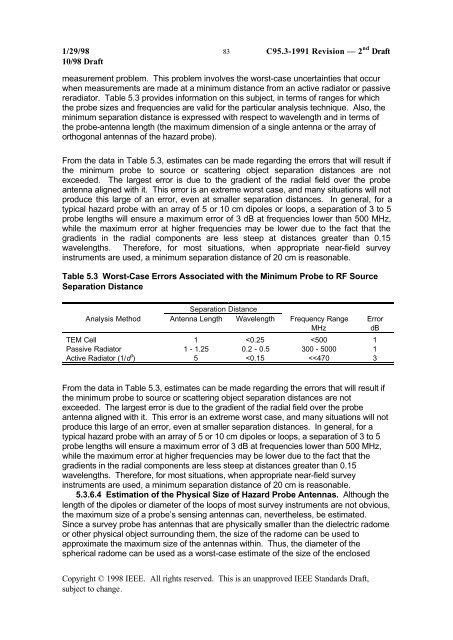DRAFT Recommended Practice for Measurements and ...
DRAFT Recommended Practice for Measurements and ...
DRAFT Recommended Practice for Measurements and ...
You also want an ePaper? Increase the reach of your titles
YUMPU automatically turns print PDFs into web optimized ePapers that Google loves.
1/29/98 83 C95.3-1991 Revision — 2 nd Draft<br />
10/98 Draft<br />
measurement problem. This problem involves the worst-case uncertainties that occur<br />
when measurements are made at a minimum distance from an active radiator or passive<br />
reradiator. Table 5.3 provides in<strong>for</strong>mation on this subject, in terms of ranges <strong>for</strong> which<br />
the probe sizes <strong>and</strong> frequencies are valid <strong>for</strong> the particular analysis technique. Also, the<br />
minimum separation distance is expressed with respect to wavelength <strong>and</strong> in terms of<br />
the probe-antenna length (the maximum dimension of a single antenna or the array of<br />
orthogonal antennas of the hazard probe).<br />
From the data in Table 5.3, estimates can be made regarding the errors that will result if<br />
the minimum probe to source or scattering object separation distances are not<br />
exceeded. The largest error is due to the gradient of the radial field over the probe<br />
antenna aligned with it. This error is an extreme worst case, <strong>and</strong> many situations will not<br />
produce this large of an error, even at smaller separation distances. In general, <strong>for</strong> a<br />
typical hazard probe with an array of 5 or 10 cm dipoles or loops, a separation of 3 to 5<br />
probe lengths will ensure a maximum error of 3 dB at frequencies lower than 500 MHz,<br />
while the maximum error at higher frequencies may be lower due to the fact that the<br />
gradients in the radial components are less steep at distances greater than 0.15<br />
wavelengths. There<strong>for</strong>e, <strong>for</strong> most situations, when appropriate near-field survey<br />
instruments are used, a minimum separation distance of 20 cm is reasonable.<br />
Table 5.3 Worst-Case Errors Associated with the Minimum Probe to RF Source<br />
Separation Distance<br />
Separation Distance<br />
Analysis Method Antenna Length Wavelength Frequency Range<br />
MHz<br />
TEM Cell 1
















